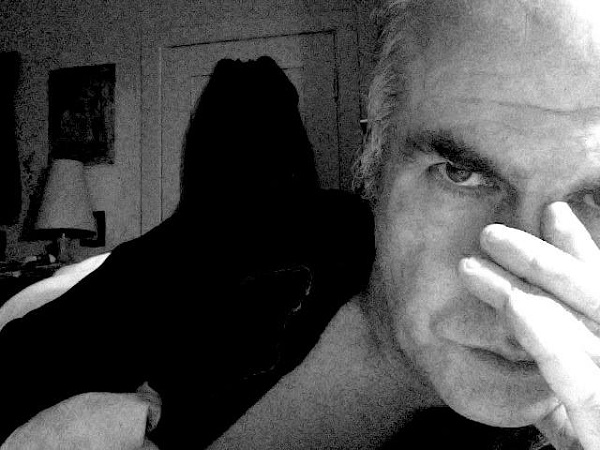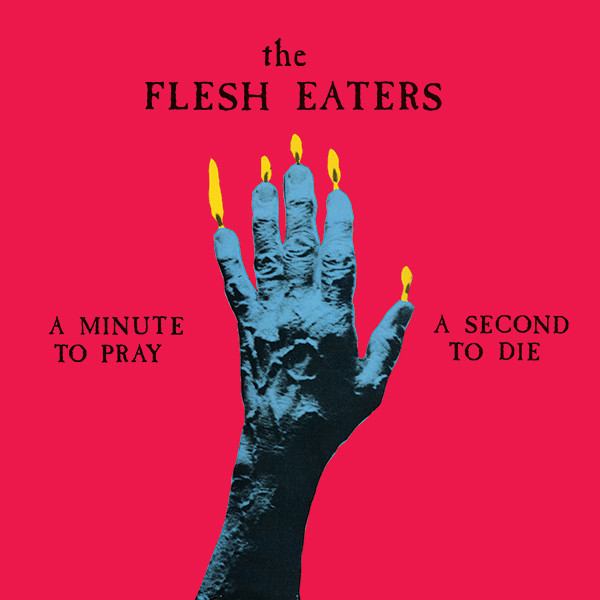
No one sings quite like Chris D. His voice, along with that of fellow L.A. punk progenitor Darby Crash (of the Germs, but you knew that, right?) was once characterized by no less than Richard Meltzer with the phrase “blabbermouth lockjaw of the soul.” Those words, colorful though they may be – and Meltzer actually put them all in caps, as you can see in his collected volume of rock writing, A Whore Just Like The Rest, pp. 302-303 – only scratched the surface of the manic howls, blistering word-spew, and snarling, tequila-soaked ferocity of Chris Desjardins’ singing voice. (This applies only to his singing with the Flesh Eaters, mind you; the singing in his acoustic work, or his various other less intense projects like Divine Horsemen, is moving and accomplished, but it’s not quite so fucking terrifying). If you’re not familiar, just check the way lyrics rip from Desjardins’ throat on “A Minute To Pray, A Second To Die” (the song, not the album) or, for instance, his whooping, demonic delivery of “Shallow Water,” both of which appear on what I hold to be the Flesh Eaters’ masterpiece, 1982’s Forever Came Today. The latter song has lyrics describing a maelstrom drowning out the singer’s voice. It would have to be quite the maelstrom.
So unique is Desjardins’ voice, in fact, that getting him on the phone, in late December 2014 – while a big deal to a lifelong Flesh Eaters fan – came as somewhat of an anticlimax. In fact, it kind of reminded me of the first time I helped arrange transportation for Eugene Chadbourne to a Vancouver gig. Somewhat to Doc Chad’s irritation – but befitting his music – I expected him to get off the plane looking like a tripped-out mad scientist (Chadbourne later quipped that “my wife gets a lot of this from local yokels who think I sit around the house playing the electric rake all the time or something”). Just as Doc Chad behaved like a perfectly normal man-with-guitars-at-an-airport, Desjardins did not howl, snarl, growl, or roar once during our phone conversation (though he did chuckle at me once). Far from the possessed wildman of the most intense Flesh Eaters’ songs, he was entirely civil, articulate, even somewhat soft-spoken during our talk, which spanned a full 90 minutes.
This relative quietness, of course, only makes him that much more fascinating.
The Flesh Eaters are staging a brief reunion tour in January 2015, with a classic line up of the band, featuring John Doe, DJ Bonebrake, Dave Alvin, Bill Bateman, and Steve Berlin – respectively, members of X, the Blasters, and Los Lobos. All of them appeared on the groundbreaking, and recently re-released punk classic A Minute To Pray, A Second to Die (originally on Ruby Records in 1981, now available through Superior Viaduct). That LP, the subsequent song of the same name, and Desjardins’ recent self-published anthology of his poetry, prose, lyrics, dream journals, and novel and screenplay excerpts, all crib their title from a somewhat less-remembered 1968 spaghetti western. (Desjardins is a film scholar whose song titles and lyrics are rife with references to the grittiest of exploitation cinema and film noir). The reissue of the LP will see this hallowed lineup playing a handful of California gigs, starting January 8th, and then travelling as far north as Seattle on January 13th, where this writer hopes to get to see them for what will be his first and no doubt only time. (It only helps my motivation that the co-headliners are Mudhoney!)

The following is a teaser for the full interview, which will appear, if the heavens align themselves correctly, in the spring issue of Big Takeover magazine. We mostly focus on A Minute To Pray, A Second To Die (the album, not the book or the song) below. Those interested in Desjardins’ filmic influences, his yakuza movie scholarship, his writing with Slash magazine, or his various novels are directed to the print edition for a more in-depth conversation than appears here, or to check out his various Facebook pages (Books by Chris D. , the Flesh Eaters page, or his Facebook homepage ).
Note: those attending the LA or Seattle shows who have hi-res photos should get in touch!
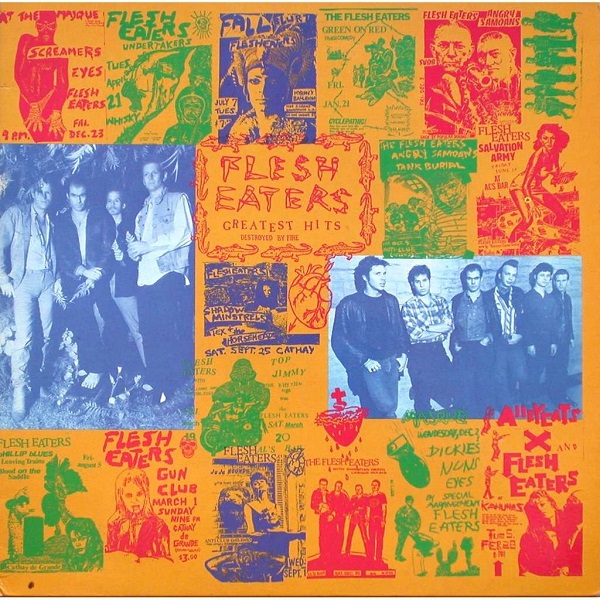
I’m wondering, based on your gig posters on the greatest hits album cover and on album cover art – like the Gun Club’s The Fire of Love, say – did you have any training in visual art?
It was just something that came naturally to me. I had some art training or something when I was a kid but not anything that would remotely lead to the kind of collage stuff that I would do later, with flyers and album covers.
Did you do any graphic stuff for Slash magazine, when you wrote for them?
No, the only graphic stuff that ever appeared by me in the magazine was when I was doing ads for my albums, like the Tooth and Nail album, I did some artwork, did some of the ads that were in there when No Questions Asked came out. But the album went defunct in December 1980, before A Minute to Pray, A Second To Die, so… just some of the ads I placed in the magazine was the only graphics I ever did.
There’s something of collage in your lyrics, as well. I was thinking: if the Misfits wrote a song called “Eyes Without a Face,” it would follow the plot of the film: it would be a song about a surgeon who cuts the faces off girls. Your song, “Eyes Without a Face,” has absolutely no bearing on the movie that I can notice.
Right.
So as devoted as you are to movies, you seem very willing to take this image here, this image there and completely transform it in the service of your own poetry.
Yeah. I totally agree. I don’t know what else to add to that, except that’s true.
Sometimes I can’t tell where something is you or something you’ve lifted from, like, a poster for an exploitation movie. A phrase like “twisted arm of illegal youth” – I could see that on a movie poster for something like Gun Crazy, you know? But maybe it’s just your writing!
Some of that – when I was in high school, I was really into student radical stuff like the SDS. I was living in Riverside California, so there was, like, no infrastructure or a group of people who were into that also. So I was like a lone wolf in terms of being into that. But once I went to college and I took LSD for the first time, all the political stuff kind of went out the window after that! But a lot of the resurgence of rebellious youth, it was just a general image, it wasn’t something that had anything to do with reality or anything that I’d been involved in. It wasn’t something where I’d gotten rousted by the police and gotten whacked on the head with a baton or anything. It was just strictly transposing what was happening. There were some punk rock riots that would happen at some concerts where the cops would show up and get a little heavy-handed in breaking up the concerts…
I remember reading a very vivid description that Alex Cox wrote about cops beating people up and he’s just walking through the scene on acid getting totally left alone… You never had any problems, though?
I was really lucky, I was never at any of those shows that got broken up. Or if they did get broken up by the cops, I headed out early, I wasn’t going to stick around and try and stand up against the police! To me that was kind of a futile gesture that could only result in grief.
There’s still a hostility towards the police in some of your song lyrics. I always thought the hubbub over “Cop Killer” was kind of funny because I’d been listening to “We’ll Never Die” (with a chorus of “shoot out the eyes of the boys in blue”) since I was a teenager.Did anyone ever raise a fuss over that song?
Well, no. There was nobody who took me to task for it. That was strictly imagery from hardboiled crime fiction and film noir movies like They Live By Night and Gun Crazy, transposed to more of an updated milieu.
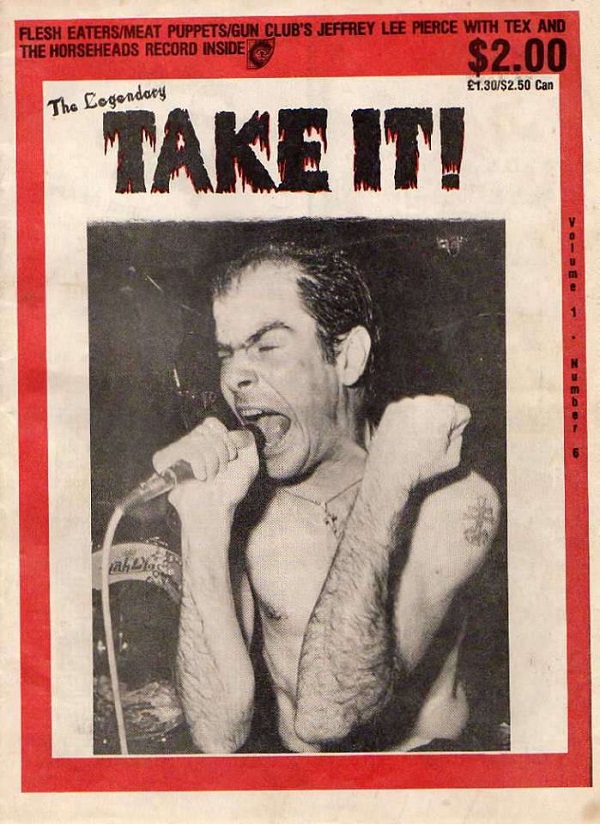
As a young writer – what were your influences?
Probably the first… I mean, I was writing short stories when I was in high school, grade school. But the first writing of mine that I was really satisfied with that was poetry, which was in the early to mid 1970’s. I did write a first novel in the mid 1970’s, a couple of science fiction novels which will probably never see the light of day. They’re kind of uneven. But I read a lot of science fiction when I was in 7th-8th-9th- grade, during that time period – Cordwainer Smith, Andre Norton, Henry Kuttner, John Brunner, John Wyndham, who wrote Day of the Triffids.
Is any of your early SF excerpted in the book of your collected writings, A Minute to Pray, A Second to Die?
The first science fiction novel I wrote is called Sacred World. There’s excerpts in there. It’s kind of a post apocalyptic kind of thing – not nuclear war, but nuclear energy having polluted a lot of urban and suburban areas. A lot of my writing, my poetry was very heavily influenced by William Burroughs and Jean Genet.
I thought I recalled someone referencing Beaudelaire and Rimbaud, in regard to you…
A little bit later on, in the later 70’s, I was getting more into people like Rimbaud, Beaudelaire, JK Huysmans, Lautréamont. By the time A Minute To Pray, the album, came out those were big influences on me. Also Edgar Allen Poe and Gaston Leroux, who wrote the original Phantom of the Opera novel, which I still think has never been filmed properly. I think all the films – the silent one, I think, comes closest to the book, but the book is so Grand Guignol and intricate in detail and I think all the movies have gone too much for the love story angle, and not been very faithful to the book.
In terms of hardboiled crime, writers like James M. Cain, when did they come into your life?
I started reading people like Raymond Chandler and Dashiell Hammett when I was still in high school probably. And definitely through college. But it wasn’t still the late 1970’s until I started to branch out and find every writer I could. James M. Cain I probably didn’t start reading until the late 1970’s. In 1980, my friend Byron Coley, who I met around that time, turned me on to a lot of people like Jim Thompson and David Goodis, Dan J. Marlowe and Harry Whittington.
In terms of the Flesh Eaters, do you have a particular favourite period or album?
Well, I really like A Minute to Pray a lot, I like the one that came after it, Forever Came Today, a lot. It’s also supposed to be re-released on CD and vinyl by Superior Viaduct next year.
That’s my favourite. I’ve always wondered about A Minute to Pray. There are some great songs on it, but it seems to me that it gets the most attention of any of the Flesh Eaters’ catalogue, is the one that people put up there, and it’s just such an odd album. It has the best cover of any Flesh Eaters album, but I wouldn’t necessarily pick it for the best album!
I think Minute to Pray is just so off kilter because of the jazz and blues influence, and the whole voodoo thing is just so pronounced on that album. You still get the same kind of lyrical stuff on Forever Came Today and Hard Road to Follow, but the music is… I hate to call it mainstream, it’s still not mainstream when you compare it to mainstream music, but it’s a little more traditional in terms of heavy rock music than A Minute to Pray. I think A Minute to Pray perhaps stuck out because of all the sax and the marimba that’s all over it. I was really trying to transcribe a lot of African and ethnic blues music and try to meld the two together, and I think a lot of that created a lot of really unique rhythms that hadn’t been heard in rock music so much. I think that’s one of the reasons it’s had its staying power, plus its reputation has only increased because it’s got a couple of people who were in X in the band [John Doe and DJ Bonebrake] and Dave Alvin and Bill Bateman, who were in the Blasters, and Steve Berlin, whose been in Los Lobos for the last few decades. The reputation of the album has only increased because of the cache of having those guys in the band with me.
Let me ask about the voodoo thing. The cover design is fantastic. Where did the idea come from, whose hand is that, where did you get exposed to the idea of the hand of glory? [From Wikipedia: “the dried and pickled hand of a man who has been hanged, often specified as being the left (Latin: sinister) hand, or, if the man were hanged for murder, the hand that “did the deed.”]
Well, I actually took that image from a frame of the original version of The Wicker Man. There’s a scene where Edward Woodward, the really straight cop who goes to the island, he wakes up one morning and there’s a hand of glory on his bedside table, and that’s the hand. I took that image out of the frame, and did different colour enhancement and stuff. And I started reading up on witchcraft and demonology and stuff like that just because it was fascinating to me. I wasn’t wanting to practice it or anything; even though I wasn’t a practicing Catholic, I still have a lot of those kind of reservations [Desjardins discusses his Catholic upbringing in the forthcoming print portion of the interview]. I didn’t want the album to be perceived as Satanic. I’ve said this in other interviews, it’s kind of an exorcism, the album is meant to be a spiritual/ personal exorcism of demons – demons of my love life…
So did you first become aware of the hand of glory through The Wicker Man?
It was through The Wicker Man first, and then I read about it in various books on witchcraft.
It interests me because it crops up in a few of your songs – of course, “Hand of Glory” on Forever Came Today, but it’s also in “The Wedding Dice” – “it’s the story of the hand of glory.” I always assumed that that song is sort of like, the backstory of the hand of glory, how the criminal that the hand came from came to be executed. I don’t know if I’m reading that right.
Well, you know, it just rhymed well with the line, “the cops say to this day it’s no heartwarming story.” I wasn’t trying to make it be literal, I wasn’t thinking in horror movie terms, this guy had a hand of glory that somehow cursed him. I was thinking more in hardboiled crime fiction terms and using that more as a metaphor than as a literal thing.
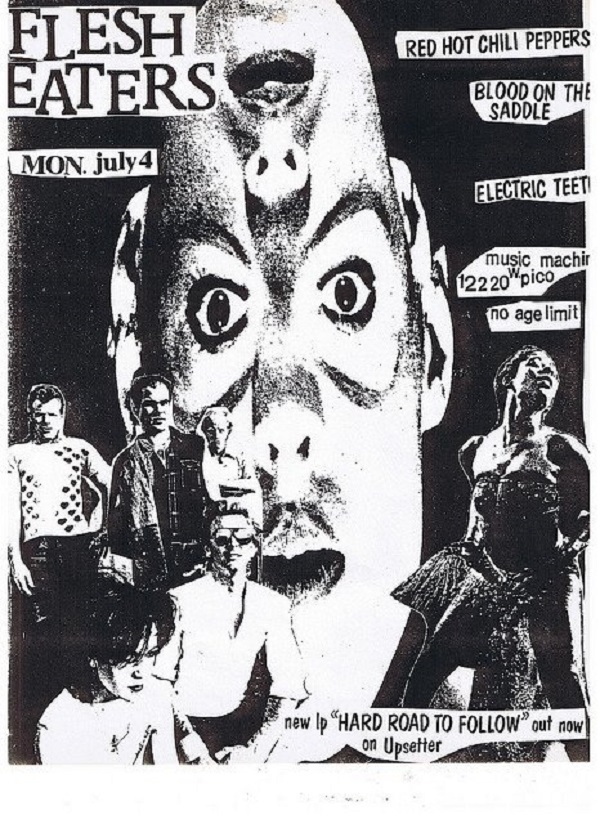
Makes sense. So – in terms of voodoo, I know in Vancouver there was actually a gallery in the 1990’s that had Santeria altars, where they did rituals, maybe they did some sacrifices, I don’t know. Was there a voodoo presence in the LA scene?
Not voodoo, but there was a Sateria presence in some of the bodegas. Like, you could go in and get little bottles of charm potions. The idea for the back cover of the Gun Club’s Fire of Love album, with all the little potion bottles. Judith Bell who did the drawings, she and I went to some bodegas that had ethnic shops that had charms and roots for sale, that were basically places you would go if you were into Santeria, and we bought some of those potion bottles just because the artwork on them was so bizarre. Judith, of course, drew her own interpretations of the Gun Club songs for the labels. The potion bottles on the cover were the closest I got to any of that stuff.
You never attended rituals or such.
No, no.
Let me ask, since the Minute To Pray album has just been reissued, and this is the lineup you’re touring, is the setlist going to include material from earlier or later versions of the Flesh Eaters, as well?
We’re going to do the whole album, we’re going to do the song “Pony Dress,” “Wedding Dice,” we’re going to do one song from Ashes of Time called “House Amid the Thickets.” We’re going to do a song from Miss Muerte called “Miss Muerte.” We’re going to do a Gun Club cover, “She’s Like Heroin To Me,” and we’re going to the Sonics’ “Cinderella.”
Cool! And just a final thing. The movie, A Minute To Pray, A Second To Die, is that a film you have any fondness for? That phrase, now – there’s an album, a song, and there’s your book now. Do you have particular regard for that movie, or do you just like the title?
I do like the movie, but I actually used that title before I ever saw the movie. I mean, I got the title from the movie, I was aware of the movie when it came out, but I didn’t get to see it when it came out in theatres. I was in high school when it came out. I saw it later on TV and got a DVD of it. You know what I found out that was interesting? I don’t know if you’ve seen the movie, but the lead actor Alex Cord plays an epileptic gunfighter and at the end of the movie, he gets reprieved, he gets amnesty from the governor. But the Italian version of the movie is about ten minutes longer, and after he gets reprieved, he ends up getting ambushed by two guys on the road and killed. The Italian version has the real downbeat ending, which makes me really wish they would release it uncut, because it’s an okay movie in the American version, but the Italian version sounds like it’s great!
